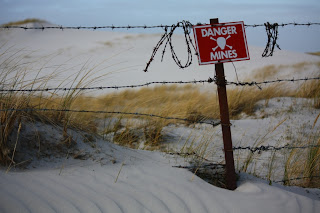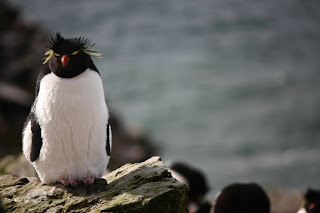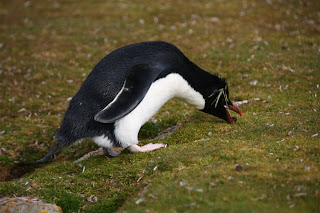Passing some quality time in Ascension.
Stanley, Falkland Islands.
On the 10th of January Falkland Islanders celebrate Margaret Thatcher Day
Our ship was not due to leave Stanley for a few days, so we passed the time by seeing the sights. Most tourists come to the Falklands to see wildlife, particularly the 800,000 odd penguins that live here. Naturally I was keen to see some penguins, despite the fact that I will be seeing nothing but penguins for the next two and a half years, so we immediately set off to Gypsy Cove, the closest penguin colony to Stanley. Contrary to what you might expect, the Falkland Islands have a lot of beautiful, white, sandy beaches, of which Gypsy Cove is one. Unfortunately beautiful, white, sandy beaches are an excellent place for invading armies to land, so during the 1982 Falklands conflict many of the beaches on the islands were liberally covered with landmines. The conflict lasted just 10 weeks, but now almost 30 years later the mines remain, and there are currently 117 minefields in the Falklands waiting to be cleared. There is a faint silver lining to this cloud, however. Penguins are not heavy enough to detonate landmines, so the penguins that live on the mined beaches do so entirely undisturbed by humans.
The legacy of the 1982 conflict lives on.
Falklands beach holiday.
Yes, it was very, very cold.
Gypsy Cove still carries landmines, but despite the barbed wire fences and skull-and-crossbones warning signs, it was starkly beautiful; all wind-blown sand dunes and hardy vegetation bathed in bright sunshine. We followed a path round the edge of the beach and pretty soon spotted a penguin – our first penguin! – a Magellanic penguin that was idly hanging out next to his burrow. As a barrage of cameras was whipped out and started clicking frantically away, he shuffled inside.
A Magellanic penguin; this one was less shy.
Not content with just one penguin experience, the next day we booked an excursion with Kidney Cove Safari Tours to see some rockhopper penguins. Kindey Cove Safari Tours is run by a couple, Adrian and Lisa, who, in between ferrying tourists to see penguins, also find time to run a 10,000 acre farm with 3000 sheep and a couple of hundred cattle. Like many landowners in the Falklands, Lisa and Adrian have penguin colonies on their land, and drive tourists out to see them to supplement their income from farming. “Tourists pay more than sheep,” Lisa explained to us on the drive over. It took a good hour to reach the colony, most of which was spent bouncing around in the back of a landrover as Lisa piloted it across rough, featureless moorland. All of a sudden we were at the penguin colony- a huddle of several hundred rockhoppers on a patch of rock at the top of a precipitous bank which plunged down into the sea. The rockhoppers were entirely unconcerned by our arrival and by the barrage of cameras. As we snapped away, they mooched, and rockhopper penguins are world-class moochers.
Moochin'
A rockhopper, living up to its name.
I wonder what they're staring at...
Rockhopper breeding season was just starting, so lots of the penguins were mooching in pairs. Some pairs were displaying to each other by throwing their heads back and letting out a throaty, braying call whilst waggling their head from side to side. This showed off their magnificent eyebrow tufts to the greatest effect. One penguin was going to even greater lengths to impress his partner. At regular intervals he would hop out of the colony onto the surrounding grass, pick up a tiny piece of goose poo in his beak, then hop back and present it to his lady, presumably to be used as nesting material.
“Hi honey! I’ve got a surprise for you!”
“Oh God. I hope it’s not more goose crap.”
“It’s some goose poo! I think it will be excellent material for building our new home!”
“How did I end up with this idiot? I hope we’re not one of those species that mates for life.”
“There’s tonnes of this stuff lying around, and it’s absolutely free! I can’t understand why everyone isn’t collecting it.”
“Perhaps because they’ve heard of toxoplasmosis.”















yaaaaay! a new post!! i need to get myself to the falklands... penguii!!!!! p.s. i LOVE your new blogger photo with the penguin. :) Can't wait for more updates!
ReplyDelete